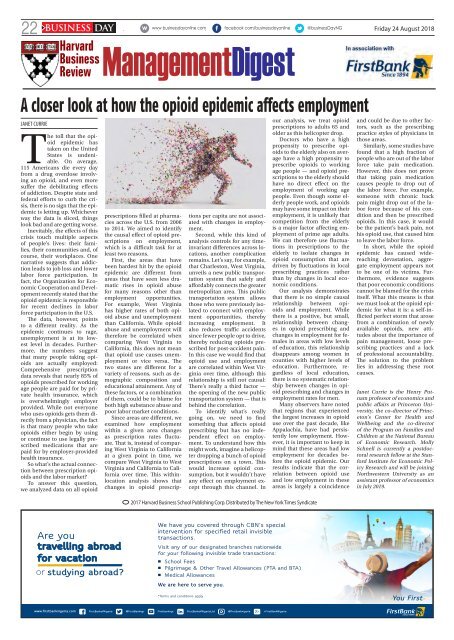BusinessDay 24 Aug 2018
Create successful ePaper yourself
Turn your PDF publications into a flip-book with our unique Google optimized e-Paper software.
22<br />
BUSINESS DAY Friday <strong>24</strong> <strong>Aug</strong>ust <strong>2018</strong><br />
Harvard<br />
Business<br />
Review<br />
ManagementDigest<br />
A closer look at how the opioid epidemic affects employment<br />
Janet Currie<br />
The toll that the opioid<br />
epidemic has<br />
taken on the United<br />
States is undeniable.<br />
On average,<br />
115 Americans die every day<br />
from a drug overdose involving<br />
an opioid, and even more<br />
suffer the debilitating effects<br />
of addiction. Despite state and<br />
federal efforts to curb the crisis,<br />
there is no sign that the epidemic<br />
is letting up. Whichever<br />
way the data is sliced, things<br />
look bad and are getting worse.<br />
Inevitably, the effects of this<br />
crisis touch multiple aspects<br />
of people’s lives: their families,<br />
their communities and, of<br />
course, their workplaces. One<br />
narrative suggests that addiction<br />
leads to job loss and lower<br />
labor force participation. In<br />
fact, the Organization for Economic<br />
Cooperation and Development<br />
recently stated that the<br />
opioid epidemic is responsible<br />
for recent declines in labor<br />
force participation in the U.S.<br />
The data, however, points<br />
to a different reality. As the<br />
epidemic continues to rage,<br />
unemployment is at its lowest<br />
level in decades. Furthermore,<br />
the numbers suggest<br />
that many people taking opioids<br />
are actually employed:<br />
Comprehensive prescription<br />
data reveals that nearly 85% of<br />
opioids prescribed for working<br />
age people are paid for by private<br />
health insurance, which<br />
is overwhelmingly employer<br />
provided. While not everyone<br />
who uses opioids gets them directly<br />
from a physician, the fact<br />
is that many people who take<br />
opioids either begin by using<br />
or continue to use legally prescribed<br />
medications that are<br />
paid for by employer-provided<br />
health insurance.<br />
So what’s the actual connection<br />
between prescription opioids<br />
and the labor market?<br />
To answer this question,<br />
we analyzed data on all opioid<br />
prescriptions filled at pharmacies<br />
across the U.S. from 2006<br />
to 2014. We aimed to identify<br />
the causal effect of opioid prescriptions<br />
on employment,<br />
which is a difficult task for at<br />
least two reasons.<br />
First, the areas that have<br />
been hardest hit by the opioid<br />
epidemic are different from<br />
areas that have seen less dramatic<br />
rises in opioid abuse<br />
for many reasons other than<br />
employment opportunities.<br />
For example, West Virginia<br />
has higher rates of both opioid<br />
abuse and unemployment<br />
than California. While opioid<br />
abuse and unemployment will<br />
therefore be correlated when<br />
comparing West Virginia to<br />
California, this does not mean<br />
that opioid use causes unemployment<br />
or vice versa. The<br />
two states are different for a<br />
variety of reasons, such as demographic<br />
composition and<br />
educational attainment. Any of<br />
these factors, or a combination<br />
of them, could be to blame for<br />
both high substance abuse and<br />
poor labor market conditions.<br />
Since areas are different, we<br />
examined how employment<br />
within a given area changes<br />
as prescription rates fluctuate.<br />
That is, instead of comparing<br />
West Virginia to California<br />
at a given point in time, we<br />
compare West Virginia to West<br />
Virginia and California to California<br />
over time. This withinlocation<br />
analysis shows that<br />
changes in opioid prescriptions<br />
per capita are not associated<br />
with changes in employment.<br />
Second, while this kind of<br />
analysis controls for any timeinvariant<br />
differences across locations,<br />
another complication<br />
remains. Let’s say, for example,<br />
that Charleston, West Virginia,<br />
unveils a new public transportation<br />
system that safely and<br />
affordably connects the greater<br />
metropolitan area. This public<br />
transportation system allows<br />
those who were previously isolated<br />
to connect with employment<br />
opportunities, thereby<br />
increasing employment. It<br />
also reduces traffic accidents<br />
since fewer people opt to drive,<br />
thereby reducing opioids prescribed<br />
for post-accident pain.<br />
In this case we would find that<br />
opioid use and employment<br />
are correlated within West Virginia<br />
over time, although this<br />
relationship is still not causal:<br />
There’s really a third factor —<br />
the opening of the new public<br />
transportation system — that is<br />
behind the correlation.<br />
To identify what’s really<br />
going on, we need to find<br />
something that affects opioid<br />
prescribing but has no independent<br />
effect on employment.<br />
To understand how this<br />
might work, imagine a helicopter<br />
dropping a bunch of opioid<br />
prescriptions on a town. This<br />
would increase opioid consumption,<br />
but it wouldn’t have<br />
any effect on employment except<br />
through this channel. In<br />
our analysis, we treat opioid<br />
prescriptions to adults 65 and<br />
older as this helicopter drop.<br />
Doctors who have a high<br />
propensity to prescribe opioids<br />
to the elderly also on average<br />
have a high propensity to<br />
prescribe opioids to working<br />
age people — and opioid prescriptions<br />
to the elderly should<br />
have no direct effect on the<br />
employment of working age<br />
people. Even though some elderly<br />
people work, and opioids<br />
may have some impact on their<br />
employment, it is unlikely that<br />
competition from the elderly<br />
is a major factor affecting employment<br />
of prime age adults.<br />
We can therefore use fluctuations<br />
in prescriptions to the<br />
elderly to isolate changes in<br />
opioid consumption that are<br />
driven by fluctuations in local<br />
prescribing practices rather<br />
than by changes in local economic<br />
conditions.<br />
Our analysis demonstrates<br />
that there is no simple causal<br />
relationship between opioids<br />
and employment. While<br />
there is a positive, but small,<br />
relationship between changes<br />
in opioid prescribing and<br />
changes in employment for females<br />
in areas with low levels<br />
of education, this relationship<br />
disappears among women in<br />
counties with higher levels of<br />
education. Furthermore, regardless<br />
of local education,<br />
there is no systematic relationship<br />
between changes in opioid<br />
prescribing and changes in<br />
employment rates for men.<br />
Many observers have noted<br />
that regions that experienced<br />
the largest increases in opioid<br />
use over the past decade, like<br />
Appalachia, have had persistently<br />
low employment. However,<br />
it is important to keep in<br />
mind that these areas had low<br />
employment for decades before<br />
the opioid epidemic. Our<br />
results indicate that the correlation<br />
between opioid use<br />
and low employment in these<br />
areas is largely a coincidence<br />
2017 Harvard Business School Publishing Corp. Distributed by The New York Times Syndicate<br />
and could be due to other factors,<br />
such as the prescribing<br />
practice styles of physicians in<br />
those areas.<br />
Similarly, some studies have<br />
found that a high fraction of<br />
people who are out of the labor<br />
force take pain medication.<br />
However, this does not prove<br />
that taking pain medication<br />
causes people to drop out of<br />
the labor force. For example,<br />
someone with chronic back<br />
pain might drop out of the labor<br />
force because of his condition<br />
and then be prescribed<br />
opioids. In this case, it would<br />
be the patient’s back pain, not<br />
his opioid use, that caused him<br />
to leave the labor force.<br />
In short, while the opioid<br />
epidemic has caused widereaching<br />
devastation, aggregate<br />
employment appears not<br />
to be one of its victims. Furthermore,<br />
evidence suggests<br />
that poor economic conditions<br />
cannot be blamed for the crisis<br />
itself. What this means is that<br />
we must look at the opioid epidemic<br />
for what it is: a self-inflicted<br />
perfect storm that arose<br />
from a combination of newly<br />
available opioids, new attitudes<br />
about the importance of<br />
pain management, loose prescribing<br />
practices and a lack<br />
of professional accountability.<br />
The solution to the problem<br />
lies in addressing these root<br />
causes.<br />
Janet Currie is the Henry Putnam<br />
professor of economics and<br />
public affairs at Princeton University,<br />
the co-director of Princeton’s<br />
Center for Health and<br />
Wellbeing and the co-director<br />
of the Program on Families and<br />
Children at the National Bureau<br />
of Economic Research. Molly<br />
Schnell is currently a postdoctoral<br />
research fellow at the Stanford<br />
Institute for Economic Policy<br />
Research and will be joining<br />
Northwestern University as an<br />
assistant professor of economics<br />
in July 2019.<br />
Are you<br />
travelling abroad<br />
for vacation<br />
or studying abroad?<br />
We have you covered through CBN’s special<br />
intervention for specified retail invisible<br />
transactions.<br />
Visit any of our designated branches nationwide<br />
for your following invisible trade transactions:<br />
School Fees<br />
Pilgrimage & Other Travel Allowances (PTA and BTA)<br />
Medical Allowances<br />
We are here to serve you.<br />
*Terms and conditions apply<br />
www.firstbanknigeria.com<br />
FirstBankofNigeria @FirstBankngr Firstbankngr FirstBankofNigeriaLtd @firstbanknigeria +FirstBankNigeria

















